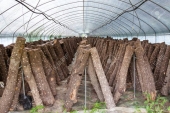I haven't built the earth berm yet. I am still trying to figure out exactly what it needs to look like.
Tentative planning has 2 aquaponics fish tanks built into the berm with just a bit of an open window or hole near the top to work with the fish. The tanks will serve as the buttress for the back wall. At floor level between the tanks and on either side of the tanks my thinking goes to run 3 vaults back into the berm and plan to grow the mushrooms with them. If I line them up with the paths in the greenhouse I will have room to pull a rolling cart out of the vault to put mushroom stuff on. I intend to use earth tube based heating and cooling to help moderate the climate in the greenhouse.(one of 7 systems stack to hopefully render the greenhouse both self heating and self cooling) Since the mushroom vaults are part of my thinking for the air systems I will describe my rough thinking there.
There would be 1 to 3 air intakes up near the ceiling to take hot air in. Run this downward through large PVC pipes as ducts down to the level where the individual 4 inch drain line plastic line take off. To keep the cost down here use cracked pipes from the local pipe dealer that I can get for next to nothing and repair them. Since the pipes are buried in the dirt of the back wall a few small air leaks won't matter. In the bottom take off to roughly 10 parallel 4" drain tile pipes that wind down in 2 or 3 layers. The bottom layer run a duct up from those pipes to the front of the side 2 vaults. Flow the air to the back of the vaults and then sidesways to the back of the center vault. The air comes through to the front of the center vault and then into a solar chimney like they are using on the passive solar dehydrators. This provides passive air flow when the sun shines. The thinking goes like this on a sunny day the hottest air in the building near the peak is sucked down into the ground where the deeper it goes the cooler it gets. When it gets to the bottom and is as cool as it can get it is then sucked back up and into the fronts of the side 2 vaults, backwards along their length and sideways to the center vault and forward along the center vault to the chimney. That means the air flowing by the mushrooms in this part of the mode should have been the most humid air in the building because it was hot to begin with. When it is cooled relative humidity should rise.(assuming moisture isn't lost to condensation which is possible) So my hope is the air would be moist enough. The mushrooms would provide CO2 to the plants and a bit of winter heat. If the greenhouse is getting to hot still then pressurize the inlet air with a blower to increase air flow and heat transfer. In the early morning dump the heated air from the chimney back into the greenhouse air. When the temperature is high enough vent the heated air outside instead. This is one of my problem areas because we just boosted the CO2 in the air and now we are dumping it instead of keeping it in with the plants. So still trying to figure out how to build a heat exchanger to vent other air instead of the CO2 ladden air from the mushrooms. At night change some flow doors so the system drew air in low from the floor on the inlet tubes rather than high and vent air about half way up the chimney. Warm air rises and direction of flow should already be established so the system should passively pump the ground and stored solar heat back up to heat at night. There again if more is need turn the blower fan on to pressurize the tubes..
The original plan was to use large scraper tires like in an earthship to make the back wall. 4 rows high and bolted together and then fill and pack with the loader/backhoe and then backfill behind In 2 of the columns cut side walls out of the lower 3 tires and add bolted on posts to the outside to maintain strength. So a 3 tire high tank area was created. Build a cob cone in the bottom and cut a window in the tread of the 3rd tire up and put a plastic pond liner in giving a cone bottom round tank of roughly 600 gallons for the cost of bolts and pond liner.(I can get the tires for free) But this one idea is shot down by perception. Everyone I talked to was concerned about the tires being toxic in some way. There isn't a single bit of good scientific evidence that they would be and even if they were most of the things a tire could put off the greenhouse environment would naturally deal with. But in this case perception is reality whether it is the truth or not. So now I am trying to figure out how to build affordable forms so I can tap the waste stream concrete from our local concrete plant. They throw away as much as a couple of hundred yards a year because of things going wrong and overages etc. By stacking solar, geothermal/ground mass,
compost internal, compost external, water storage heat, Rocket mass heater and bugs/animals/mushroom I think it should be possible to build a system that will basically heat itself all winter long even in harsh WY winters.







































